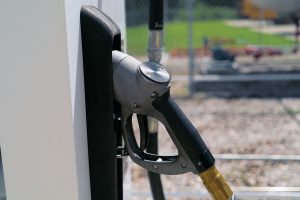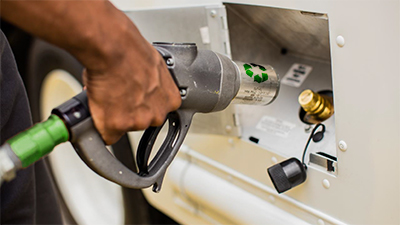Propane Autogas Reduces Emissions, One Gallon at a Time
Leading the Way
Packing a cleaner, greener approach to transportation, propane-autogas-powered vehicles significantly reduce emissions, with 12 percent less carbon dioxide, about 20 percent less nitrogen oxide, up to 25 percent less greenhouse gases, and up to 60 percent less carbon monoxide than gasoline-powered vehicles.
Greenhouse Gas Emissions
Propane is a low-carbon alternative fuel that produces significantly fewer greenhouse gas emissions than electricity and many other fuels. According to the Intergovernmental Panel on Climate Change, propane autogas is not a direct greenhouse gas when released into the air, and current research measurements have found no global climate impact from propane autogas emissions.
What does that mean for fleet operators and vehicle owners? When compared to conventional fuel sources, propane generates fewer greenhouse gas emissions in almost every application — including as an automotive fuel. Tank by tank, propane autogas has a lower carbon content than gasoline, diesel, heavy fuel oil, or even biodiesel and ethanol.
Quantifying Emissions
When quantifying the greenhouse gas emissions that result from the use of energy, it is important to distinguish between the emissions released at the location where the energy is consumed and the emissions released as a result of extracting, processing, and delivering a refined and usable energy product to that location. The fuel lifecycle begins where the raw feedstock is extracted from the well or mine and ends where the fuel is consumed to power a vehicle, appliance, or other technology.
The carbon footprint of propane autogas is relatively small compared to other fuels in terms of total emissions and emissions per unit of energy consumed.
Figure 1 shows the relative carbon dioxide emission rates for various fuels. With the exception of natural gas, propane autogas has the lowest emission rate of the major energy sources. Electricity is included in this chart based on the average U.S. emissions of the power generation industry.

Emissions released at the point of use are termed ‘end-use’ emissions, while those emissions that occur along the delivery pathway are termed ‘upstream’ emissions. Upstream emissions include all emissions resulting from the recovery, processing, and transport of fuel to the point of delivery to the end-user.
Energy use is not the only source of upstream emissions. Other production processes also release greenhouse gases. For example, the growing of crops for the production of biofuels requires the application of nitrogen fertilizer, which causes the formation of nitrogen oxide. Additionally, natural gas refining causes the release of fugitive emissions of methane. These processes have been quantified by GREET, the Greenhouse Gases, Regulated Emissions, and Energy Use in Transportation model, making it a creditable comparison of lifecycle analyses of fuel systems.
The inclusion of upstream emissions in an analytical comparison of different fuel options can have a significant impact on the results. Limiting the comparison to end-use emissions only, for example, can give the impression that electricity, with zero end-use emissions, is an energy source with no greenhouse gas emissions. Limiting the evaluation to end-use emissions only would mask the very large fraction of upstream emissions caused by the combustion of fossil fuels for the purpose of electricity generation.
A Clean-Burning Fuel
Propane autogas, one of the cleanest burning fossil fuels, is an approved, clean fuel listed in the 1990 Clean Air Act and the Energy Policy Act of 1992. Tests conducted by the U.S. Environmental Protection Agency show that propane autogas vehicles can produce 30 to 60 percent less carbon monoxide emissions, 80 percent reduction in exhaust coarse particulate matter, up to 95 percent reduction in evaporative volatile organic compounds, and approximately 50 percent fewer toxins and other smog-producing emissions when compared to gasoline engines.
Propane autogas can also provide significant benefits in fighting global climate change, because it contains less carbon per unit of energy than either gasoline or diesel, resulting in significantly lower greenhouse gas emissions when burned. Fleets using propane autogas can breathe easier knowing that, unlike methane (the primary constituent of compressed natural gas), propane autogas is not a greenhouse gas when released into the atmosphere.
Environmental Benefits
Propane autogas is a clean-burning fuel that is environmentally friendly. Try our Savings Calculator & Emissions Calculator to calculate your potential savings.
Here are some of the proven emissions benefits of propane autogas:
- Propane autogas exhaust creates 60 to 70 percent less smog-producing hydrocarbons than gasoline (Southwest Research Institute).
- Compared to gasoline, propane yields 12 percent less carbon dioxide, about 20 percent less nitrogen oxide, and as much as 60 percent less carbon monoxide (World Liquid Propane Gas Association, January 2003; California Energy Commission, January 2003).
- Propane autogas cuts emissions of toxins and carcinogens, like benzene and toluene, by up to 96 percent when compared to gasoline (Southwest Research Institute).
- Propane is a low-carbon alternative fuel that produces significantly fewer greenhouse gas emissions than diesel and gasoline in a wide range of applications (Propane Education & Research Council).
- Propane autogas has an octane rating of 106 (compared to premium grade gasoline of 91 to 92), which allows for a higher compression ratio in the engine and greater engine efficiency. This leads to significant reductions in exhaust emissions like carbon monoxide (Argonne National Laboratory).
For more information on propane emissions:
Department of Energy’s Alternative Fuels & Advanced Vehicles Data Center statistics.
Autogas for America’s propane autogas emissions graphs.













